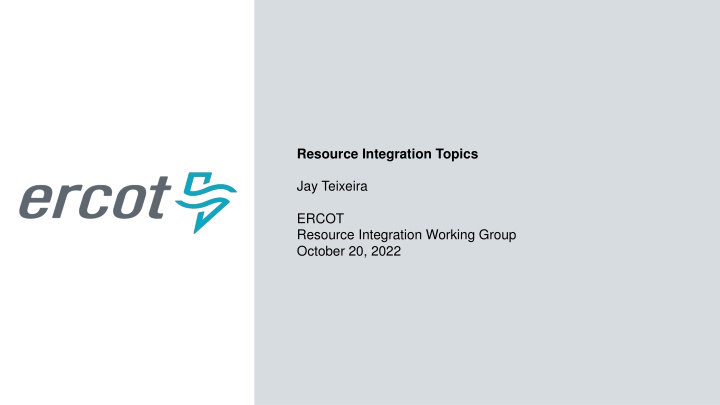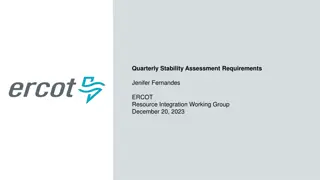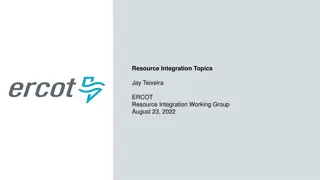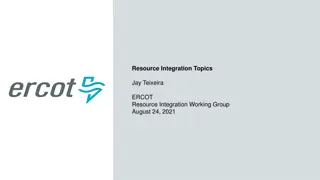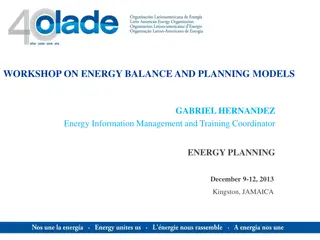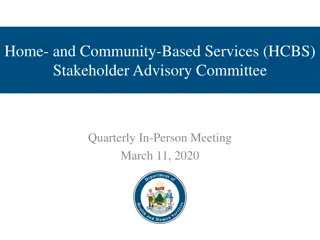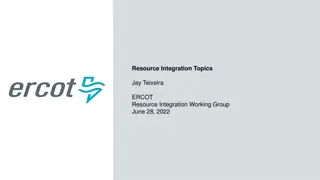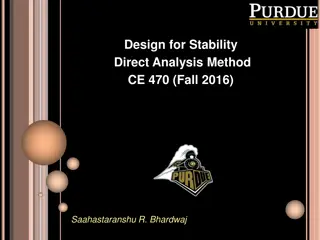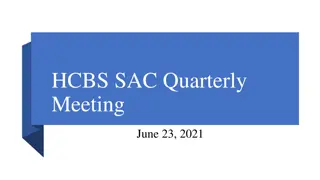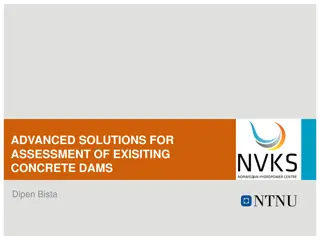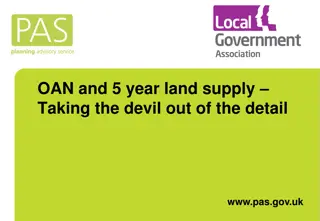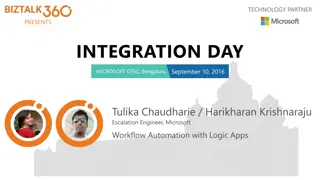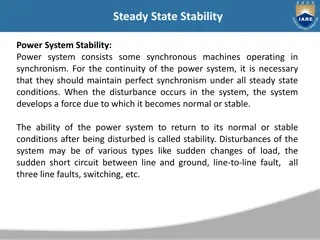Resource Integration Topics and Quarterly Stability Assessment Planning Guide
The content discusses resource integration topics and the Quarterly Stability Assessment (QSA) planning guide for ERCOT. It provides information on important deadlines, synchronization dates, modeling requirements, and processes for large generation projects seeking simultaneous screening and full interconnection studies. The details cover various aspects related to IE submissions, milestones, approvals, studies completion, and overall timeline considerations.
Download Presentation

Please find below an Image/Link to download the presentation.
The content on the website is provided AS IS for your information and personal use only. It may not be sold, licensed, or shared on other websites without obtaining consent from the author.If you encounter any issues during the download, it is possible that the publisher has removed the file from their server.
You are allowed to download the files provided on this website for personal or commercial use, subject to the condition that they are used lawfully. All files are the property of their respective owners.
The content on the website is provided AS IS for your information and personal use only. It may not be sold, licensed, or shared on other websites without obtaining consent from the author.
E N D
Presentation Transcript
Resource Integration Topics Jay Teixeira ERCOT Resource Integration Working Group October 20, 2022
Quarterly Stability Assessment (QSA) Planning Guide 5.9 Next Deadline for QSA All-Inclusive Generation Resource Initial Synchronization Date Upcoming January, February, March Last Day for an IE to meet prerequisites as listed in paragraph (4) below Prior August 1 Completion of Quarterly Stability Assessment End of October Prior November 1 End of January Upcoming April, May, June Prior February 1 End of April Upcoming July, August, September Prior May 1 End of July Upcoming October, November, December If a GINR is not included in QSA, its Initial Synchronization date will be automatically delayed to the next quarter 2
Quarterly Stability Assessment (QSA) Planning Guide 5.9, Quarterly Stability Assessment Issue s seen in previous QSA s 10 day comment period for FIS Needs to be complete before QSA deadline TSPs need to plan for it Dynamic/PSCAD Model Review Dependent on FIS Stability study Need to meet PG 6.9 15 to 30 days prior to QSA deadline PSSE Model Quality Test Required PSCAD Model Quality Test and Unit Model Validation required TSAT Model Required If PSSE model is UDM, then TSAT model should be UDM 3
Current Process for Large Generation Project Wanting Simultaneous Screening Study and Full Interconnection Study (No Construction Bottleneck) 20 Months Assumptions IE submits correct data IE meets all milestones IE does not change equipment TSP has no backlog 6/21/2020 Part 1 Approval 2/1/2020 QSA Deadline 5/1/2020 QSA Complete 7/1/2020 Part 2 Approval Earliest Sync Based on QSA 7/1/2019 Reactive Study 4/1/2019 SS Complete 1/1/2019 6/1/2020 PLD* INR Request Initiated 9/1/2020 Part 3 Approval 1/1/2019 9/1/2020 TSP Complete FIS (10 months) Range 9 to 13 months Kick-Off -2 weeks Sign Study Scope months Received Payment 1 month SS Study months SC month Dynamic months Facility months ERCOT Approved 11/1/2019 - 2/1/2020 2/1/2020 - 6/1/2020 SGIA, NTP & Financial Commitment Days RARF Submission 7/1/2020 - 9/1/2020 2/1/2020 - 7/1/2020 Testing ~5 months SSR Study Completed and Approved *Interim updates are not allowed for new units. Interim update requests must be approved by ERCOT Network Modeling. Construction time for TSP to construct needed facilities not shown. Start of construction dependent on RE giving TSP Notice to Proceed and providing the Funding to construct the interconnection facilities. Length of time needed for construction depends on facilities being constructed. The PLD shown above is normally after completion of construction. 4
New Process for Small Generators TDSP Work Prior to RIOO Submittal (8 to 10 Months Timeline for Projects After the DGR Moratorium) 5/19/2022 Part 1 Approval 1/14/2022 Review required Submissions 1/31/2022 Registration RARF Approval 10/3/2021 Optional Small Gen Review Meeting 1/18/2022 Review RARF 5/31/2022 Part 2 Approval 1/4/2022 5/4/2022 PLD* 7/31/2022 Part 3 Approval Submit INR in RIOO 10/1/2021 8/1/2022 5/4/2022 - 7/31/2022 2/1/2022 - 5/1/2022 10/1/2021 - 1/1/2022 Commissioning Checklists & Testing Days RARF Submission (Prior to PLD) IE/RE Work with TDSP (IA, System Impact Studies, Interconnection Requirements, Operational Limitations, ETC) *Interim updates are not allowed for new units. Interim update requests must be approved by ERCOT Network Modeling. Construction time for TSP/DSP to construct needed facilities not shown. Start of construction dependent on RE giving TSP Notice to Proceed and providing the Funding to construct the interconnection facilities. Length of time needed for construction depends on facilities being constructed. The PLD shown above is normally after completion of construction. RE should have all TSP/DSP studies and IA complete before requesting the scoping meeting. 5
New Process for Small Generators RIOO Submittal Prior to TDSP Work (8 to 10 Months Timeline for Projects after DGR Moratorium) 8/27/2022 Part 1 Approval 4/30/2022 Registration RARF Approval 4/1/2022 1/9/2022 Optional Small Gen Review Meeting Submit required Submissions 4/14/2022 Review required Submissions 9/5/2022 Part 2 Approval 1/4/2022 8/3/2022 PLD* 4/18/2022 Review RARF Submit INR in RIOO 10/31/2022 Part 3 Approval 1/4/2022 11/1/2022 1/4/2022 - 4/1/2022 8/3/2022 - 11/1/2022 5/1/2022 - 8/1/2022 IE/RE Work with TDSP Commissioning Checklists & Testing Days RARF Submission (Prior to PLD) IE/RE Work with TDSP (IA, System Impact Studies, Interconnection Requirements, Operational Limitations, ETC) *Interim updates are not allowed for new units. Interim update requests must be approved by ERCOT Network Modeling. Construction time for TSP/DSP to construct needed facilities not shown. Start of construction dependent on RE giving TSP Notice to Proceed and providing the Funding to construct the interconnection facilities. Length of time needed for construction depends on facilities being constructed. The PLD shown above is normally after completion of construction. RE should have all TSP/DSP studies and IA complete before requesting the scoping meeting. 6
Submitted Questions How do we calculate the required MVAR at the POI Bus? Is it based on the maximum net MW at the POI or the maximum net MW at the POI Bus? The reactive requirement at the POIB is based on the maximum net MW of the generating unit (i.e. does not include addition station load behind the POIB that is not part of the generating unit) that can be supplied at the POIB Question for TSPs: Do TSPs provide the REs with line parameters of tie line? 7
Submitted Questions Since the number of PUN loads interconnecting behind the meter of the generation resources is increasing, what is ERCOT s expectation in terms of how the project shall compensate for the reactive power consumed by the PUN Load? Can automatically switchable static VAr-capable devices be used to compensate for the reactive power consumed by the PUN loads OR only the generating unit s dynamic leading and lagging operating capability, and/or dynamic VAr-capable devices are acceptable to compensate for the reactive power consumed by the PUN loads? The load has an obligation to maintain a power factor of .97 or better, not considering any reactive capability required by the generator. Static reactive devices can be utilized to adjust to MVAR loading changes throughout the operating day to maintain this .97 power factor or better. Typically, the generating units required dynamic reactive capability at the POIB is preserved by its own shunts needed to compensate for voltage losses up to the POIB, so the total reactive needs must be coordinated to be met by the load and its reactive devices (.97 pf or better), the generator and its reactive capabilities (.95 lead/lag at the POIB + any supplemental to compensate for losses), and transmission operator supplied MVAR capability ( to serve the remaining MVAR load). 8
Submitted Questions Inclusion of DYR, raw file or other current model data in RIOO-RS and made accessible to RE. The RE desire is to be able to see model data as it currently exists and all attachments at anytime. This will be included early next year in RIOO-RS. 9
VSS Requirement NPRR1005-Clarifying the definition of POI and POIB was implemented on Feb 1st, 2022. Nodal Protocol 2- Point of Interconnection Bus (POIB): Electric Bus at the TSP substation that is electrically closest to the Generation Resource s POI or any electrically equivalent Electrical Bus at that station. Nodal Protocol 3.15 (4): VSS requirement is at the POIB. Reactive Study should account for the gen-tie line regardless of ownership. Part 3 Test: VSS requirement is calculated at the POIB. 10
Part 3 Tests: Co-located Resources behind the same POI Reactive Test- Each Resource (solar, storage) is tested individually to meet requirement per NOG 3.3.2.2 VSS: Each Resource independently and combined must meet VSS per NP 3.15. Solar Storage Solar + Storage AVR Test- Test three scenarios Solar Storage AVR test can be run at night. Solar + Storage: the combined test is to verify that the plant can control the voltage at the POIB with both Resources online. 11
Active RRs None 12
Other contact information ResourceIntegrationDepartment@ercot.com is distribution list for Resource Integration department Mailing List RESOURCE_INTEGRATION@LISTS.ERCOT.COM 13
Questions? Thank you!
